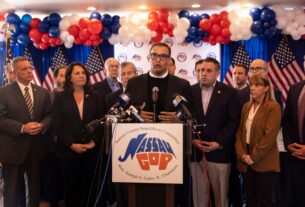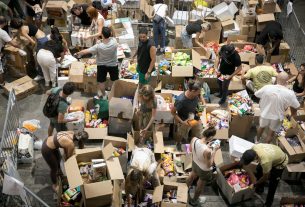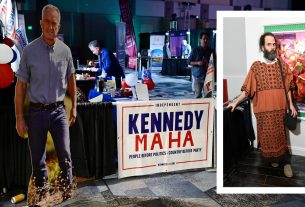TWO WEEKS AGO, when fighting ignited across Israel’s so-called “mixed cities” between far-right Jewish vigilantes and groups of mostly young Palestinian men, the city of Lod (in Arabic, Lydda) was the epicenter. After a May 10th demonstration by Palestinian citizens of Israel—who make up roughly a quarter of the city’s population—armed Jewish residents shot and killed Mousa Hasouna, a 32-year-old Palestinian man. Hasouna’s funeral the following day sparked even fiercer protests. Palestinian demonstrators threw stones, burned cars, and set fire to several synagogues. A 56-year-old Jewish man, Yigal Yehoshua, was struck when his car was pelted with bricks and rocks; he died in the hospital several days later. On May 12th, Prime Minister Benjamin Netanyahu declared a state of emergency in the city—the first use of emergency powers on Palestinian citizens of Israel since martial law over Arab cities and towns ended in 1966—and police imposed a curfew.
Yet the state of emergency did not prevent hundreds of armed Jewish settlers from flooding into the city from the occupied West Bank that night and over the following days. According to Haredi journalist Israel Frey, “battalions” arrived in the city on buses from extremist settlements and illegal outposts in open violation of the curfew. Their presence had been requested by members of Lod’s Torah Nucleus—an association of right-wing religious Zionists who have settled in Lod with the explicit aim of bolstering the size of the city’s Jewish population. And while police had met the Palestinian demonstrators with rubber-coated bullets and stun grenades, they greeted the armed settlers and local right-wing activists with tacit, and in some cases open, support. In video footage captured by Israeli photojournalist Oren Ziv, settlers and police stand shoulder-to-shoulder, throwing, respectively, rocks and stun grenades at a group of Palestinian men guarding a mosque.
There are many factors that led to the scale of violence in Lod: grinding inequality in what is one of Israel’s poorest cities; housing and development policies that disadvantage Palestinian residents; Palestinians’ anger over abuse at the hands of the police. But there is little doubt that the presence of the Torah Nucleus is part of what made the situation in the city so combustible. As early as 2013, Haaretz’s Gideon Levy warned that Lod’s religious nationalist outpost was likely to cause the city “to explode.”
The Torah Nucleus in Lod—like those in other so-called “mixed” cities such as Acre and Jaffa—represents the transposition of the settler movement’s messianic, territorial-maximalist ideology back within the Green Line. In a 2017 interview with the Israeli business paper Calcalist, Shilo Hendler, one of the leaders of Lod’s Torah Nucleus, remarked that settling in Lod “was no less a task of national importance than living in Nablus”—a Palestinian city in heart of the West Bank. But whereas the settler movement’s primary aim in the West Bank is to secure as much land as possible for Jews, and thus to prevent the creation of a Palestinian state, the movement’s goal inside Israel is to maintain a Jewish majority in the country’s cities—by pushing Palestinians out. “They have a racist agenda,” said Lod-born filmmaker Rami Younis in 2014. “They’ve moved to a city with a large Arab population for one reason: to Judaize it.”
Perhaps more than any other city in Israel, Lod exemplifies how the settler right has succeeded in taking hold of state power to further its aims. The religious nationalist movement perfected this strategy over the last three decades, securing funds and military backing for Jewish settlement in the occupied West Bank. Now, it has brought that strategy inside Israel. Religious Zionist operatives have become adept at funneling government money to initiatives like the Torah Nuclei, and religious Zionist politicians have gained substantial sway in key government ministries. In Lod, the Torah Nucleus—which has grown to more than 1,000 families across the city’s neighborhoods—has taken over leadership of the municipality: The mayor is a member; the city’s chief executive officer is one of its founders. Lod, then, is a settler city—a representation in miniature of what the settler movement aims to do to the entire Israeli state. The violence of the last few weeks is a harbinger of what Israel might look like if they get their way.
THE RELIGIOUS ZIONIST RIGHT “wants to reshape Israeli political and cultural life in their own image,” explained Liat Schlesigner, executive director of the progressive Israeli think tank Molad. Although religious Zionists represent only a small segment of Israel’s population—roughly 10%—they have gained outsize influence not only in government, but also in the army and the media. Exact numbers are hard to come by, but a significant proportion of Israeli army officers today come from religious Zionist backgrounds. Religious Zionist journalists from West Bank settlements, such as Channel 12’s Amit Segal and Israel Public Broadcasting’s Akiva Novick, are among the most prominent figures on Israeli TV news. It is not surprising, then, that once-fringe political positions of right-wing religious Zionism are becoming increasingly mainstream. A 2016 Pew Survey found that more Israeli Jews agree that “Arabs should be expelled or transferred from Israel” than disagree.
It was not always like this. In the wake of the Oslo Accords in the early and mid-1990s, religious Zionist leaders lamented that the Israeli public seemed to have consented to territorial compromise—to giving up on the entirety of “Greater Israel.” “We settled on the hills,” leading religious Zionist rabbi Yoel Bin Nun famously remarked in 1991, “yet we failed to settle in the hearts of Israelis.” The settler movement’s sense of failure only became more acute in 2005, when Israel unilaterally withdrew Jewish settlements from the Gaza Strip. Settler activists tried in vain to spark a national movement against the Gaza disengagement, which was carried out by former settlement champion Ariel Sharon and supported even by stalwarts of the Israeli right like Netanyahu.
Settler leaders’ recognition that their movement lacked widespread popular support led them to adopt a new strategy. Settling “in the hearts of Israelis,” they decided, required spreading the good word of religious Zionism in Israel’s metropolitan core, living among secular Israelis who did not share the settlers’ messianic vision. For this reason, the bulk of the Torah Nuclei founded over the last decade and a half can be found in greater Tel Aviv and its suburbs, though there are religious nationalist outposts in former development towns on Israel’s socio-geographic periphery. Regardless of location, each nucleus’s goals are to combat the influences of liberalism and secularism, to bring the local Jewish population closer to traditional Orthodox Judaism, and to impart on them the divine significance of Jewish sovereignty over the entire land of Israel. These efforts have not turned most Israelis into religious Zionists. However, in tandem with the settler movement’s increasing representation in Israeli public life, religious Zionist ideas have made undeniable inroads into mainstream opinion: The 2016 Pew Study also found that 42% of Israeli Jews believe continued settlement construction in the West Bank aids Israel’s security, compared to just 30% who disagree; 79% of Israeli Jews believe Jews should receive preferential treatment over non-Jews; and 60% of Israeli Jews, excluding West Bank settlers, believe God gave the Land of Israel to the Jewish people.
In Israel’s so-called “mixed” cities, targeted by Torah Nuclei because of their large Arab populations, the presence of religious Zionist outposts has upset the uneasy but generally peaceful side-by-side existence of Palestinians and Jews. In Jaffa, the Torah Nucleus association’s decision to establish a yeshiva in Ajami, one of the city’s last remaining Arab-majority neighborhoods reflects the desire to increase confrontations between the yeshiva community and Palestinian residents. In Acre, members of the city’s Torah Nucleus have turned public celebrations into aggressive demonstrations of Jewish presence—for instance, by marching through largely Palestinian neighborhoods during the Jewish holiday of Simchat Torah. In Lod, where members of the Torah Nucleus have been seen walking around open-carrying assault rifles even before the most recent violence, the mayor tried to silence the city’s mosque’s call to prayer. “It is Jewish supremacism in its essence,” said Molad’s Schlesinger of the ideology behind the Torah Nuclei. The underlying message is “that Arabs need to know their place, that they are mere guests here, and that they need to act accordingly.”
The Torah Nuclei receive substantial backing from Israel’s government, as Schlesinger and Molad found in an extensive report. According to Molad, in 2014 more than three-quarters of religious Zionist nuclei received funds from the World Zionist Organization’s Settlement Division—a notoriously opaque para-state institution funded by the Israeli government, and the means by which Israel apportions land to Jewish settlers in the West Bank. In 2014, the religious Zionist Yeshivat Shirat Moshe in Jaffa received 791,714 shekels from the Settlement Division and more than half a million shekels from Israel’s Education Department. Other religious Zionist nuclei received similar sums from the Settlement Division: the nucleus in Acre, 350,000 shekels; the nucleus in Lod, 526,000 shekels. In an interview, Schlesinger said that state funding for the Torah Nuclei had only increased. The nucleus in Lod, for instance, received roughly 1.4 million shekels from the Israeli government in 2020. These sums reflect the success of the settler movement’s dual power strategy, which involves using the state apparatus to funnel resources toward religious nationalist initiatives even as the movement operates its own organizations independent of the state.
Lod, which is home to the country’s largest Torah Nucleus, epitomizes this dynamic. For the city’s Palestinian residents, the nucleus and its institutions represent not only an ideological commitment to Judaizing the city, but also the threat of gentrification. In 2015, the city completed construction of the Ramat Elyashiv housing complex for members of the Torah Nucleus, a modern condo complex towering over the impoverished city. Arab residents are barred from living in the development, yet they must live with the consequences of such building projects, and of the accompanying influx of Jews that has displaced longtime working-class Palestinian residents. “They’ve raised the prices of the houses in the Old City in Lod to such an extent that a young Arab couple cannot afford a home,” Lod resident Ghassan Munayyer told Haaretz’s Lior Kodnor. “All of the city’s resources are invested for the benefit of the Jewish residents.”
In the wake of the violence in Lod and other so-called “mixed” cities, Israeli media—and US publications—have framed the events as an upsurge of ancient intercommunal hatred. Yet the root causes do not lie in a bygone epoch. In Lod, as in Acre and Jaffa, Palestinian citizens of Israel were reacting to an increasingly urgent threat of displacement from neighborhoods they’ve inhabited for decades. This is, in part, why the institutions of Lod’s Torah Nucleus—the yeshiva, the pre-military academy—bore the brunt of the protesters’ rage. They embodied not simply the threat of expulsion, but also the underlying project of Judaization: an effort that, in Lod and elsewhere, is driven by right-wing groups like the Torah Nuclei, but supported financially by the Israeli government and ideologically by a broadening swath of Israeli society. Indeed, the sense that the city and the settler movement have become indistinguishable is implicit in the way members of the religious Zionist outpost responded to the demonstrations. “It is not a coincidence that when the riots started, they called people from the settlements to defend the city,” explained Shai Agmon, a research fellow at Molad. “They called people from the ideological settlements to demonstrate that they are the owners of this country.”
Since Israel and Hamas declared a ceasefire on Friday, the mass demonstrations and vigilante violence in cities like Lod have largely abated. They have given way to a massive arrest campaign carried out by Israeli forces largely against Palestinians suspected of having participated in the protests. Human rights attorney and general director of the Adalah legal center Hassan Jabareen said in a statement that this police operation constitutes “a war against Palestinian demonstrators [and] political activists . . . intended to intimidate and exact revenge on Palestinian citizens of Israel.” The Israeli daily Yediot Ahronot reported that the police “intends to ‘settle the score’ with criminal elements in the Arab sector.” Video of arrests in cities such as Lod, Jaffa, and Jerusalem show Israeli police pinning Palestinians to the ground, in many instances blindfolding them before taking them away. In just the last two weeks, Israel’s national police have made more than 1,550 arrests. Mohamed Barakeh, chair of the High Follow-Up Committee for Arab Citizens of Israel, the central Palestinian civil society organization in Israel, warned, “The police are going to reignite the streets.”
For the religious Zionist right, such an escalation is desirable. They have taken the events of the last two weeks, though bloody and difficult, as confirmation of their fundamentalist worldview: that Jews and Palestinians cannot inhabit the land together. Far-right political figures such as Betzalel Smotrich, leader of the Religious Zionism party, and Itamar Ben-Gvir, leader of the Kahanist Jewish Power party, continue “celebrating the mounting tension,” Schlesinger said. “They are actively working against efforts to calm things down, because part of their political project is to demonstrate the impossibility of a shared society in Israel.” Already, the right-wing politician Naftali Bennett has used the unrest as a pretext to rule out any parliamentary coalition that includes the Arab-led parties. Others may follow.
In the decades since Bin Nun’s remarks about “settling in the hearts,” even if the religious Zionist movement has not converted the majority of Israelis to nationalist Orthodoxy, it has largely succeeded in bringing elements of its ideology into Israeli common sense. On Israeli TV, mainstream journalists echo the settler right’s talking points: that the conflict is zero-sum; that Israel’s enemies, internal and external, must be destroyed; that eventually Israeli Jews may be left with no choice but to expel Palestinians from the Land of Israel if they are ever to live in peace. Though Israel was founded by settlers, the Israeli government has for many years preferred to frame the settlements in the West Bank as temporary or somehow separable from Israel itself. But now the settlement movement seems to have overwhelmed Israel, as its logic and its shock troops have flowed back over the Green Line, suggesting the emergence of a new phase of the settler state. The appearance of armed West Bank settlers patrolling Israeli streets suggests not only the shifting balance of power, but also the violent future that a settler-run state will entail. “I have a theory, according to which one day there will be a second War of Independence,” tweeted Naveh Dromi, a right-wing, secular Israeli journalist amidst last week’s violence, “during which we will again liberate the Temple Mount, the Tomb of the Patriarchs, and the Gaza Strip. For the Palestinians it will be a second Nakba. What’s happening now only strengthens my thesis.”
Joshua Leifer is an assistant editor at Jewish Currents.
The post The Rise of the New Settler State appeared first on Jewish Currents.



